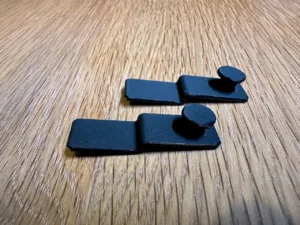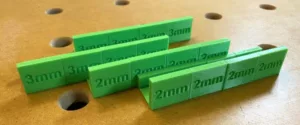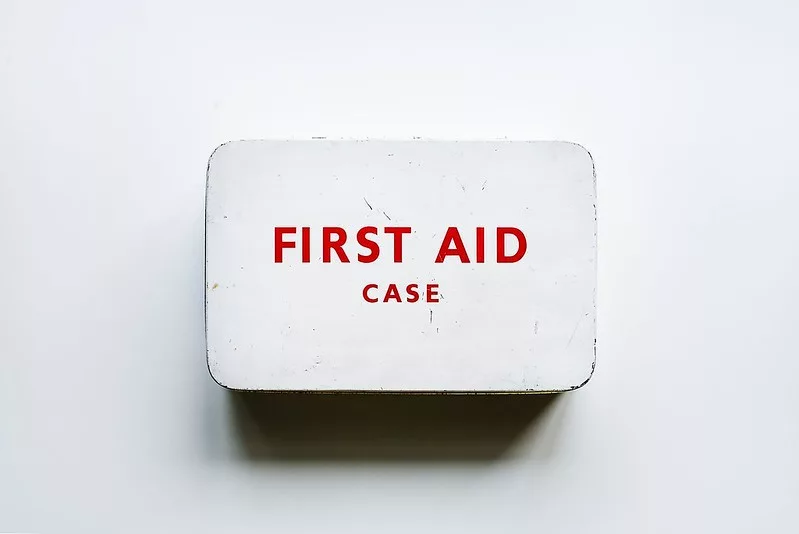You’ve been good. You’re paying attention and you have your safety gear on. Look at you go. Being diligent in the workshop is very important and I can’t stress its importance enough.
That said, there is still a possibility something can go wrong. I’m not trying to be a downer, but accidents happen and it’s important to prepare for that possibility. Someone once said fortune favors the prepared. So what can you do to prepare for accidents in your shop?
Step one is having the shop safety equipment we talked about before. Step two is having proper first aid equipment easily accessible. There are plenty of first aid kits you could buy and they should be able to handle the small things; minor cuts and the like.
Since we’re potentially working around equipment weighing hundreds of pounds, using higher voltage electricity, and spinning death discs (saw blades) or spiral swords (drill bits) at thousands of RPMs, you’re going to want to have a little more than bandaids and Neosporin at the ready.
Severe Injury
Most of us have seen those poorly made shop safety videos with people leaning across spinning saws and getting loose clothing stuck in machines. The effects were terrible and we probably laughed at least once. Rewatching those we’d probably laugh even more at how dumb they’d have to be or that we’re infinitely more conscious about the tools in our shop.
Listen. Nobody wants to talk about this and I get it. The idea of injuring yourself so badly that digits or limbs are at stake is awful. I wish that on nobody, ever. But it does happen. Not all the time, but sometimes. You don’t want to be the person unprepared for that scenario.
A few things to keep in your shop, at the ready, to help with severe injuries are tourniquets and heavy gauze.
Tourniquets
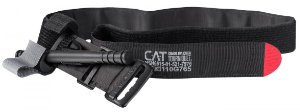
Knowing where and how to properly apply a tourniquet could prevent you from permanently losing a finger or even part of an arm or leg. You need to have your tourniquets ready and out of the packaging. I learned this tip from Jonathan Katz-Moses’ video on shop safety.
The medical professional he spoke with made the point that if you’ve only got one hand and it’s potentially covered in slippery blood, how the heck are you going to open the package your tourniquet is in?! I have issues opening packaging some of these items come in on a good day. When you buy one (or more), take it out of the packaging. Set it up to be ready for use. Then practice a few times. Do it while you’re watching TV or YouTube.
Here are a few videos on how to apply tourniquets:
- Seattle Office of Emergency Management tourniquet application
- Fire Fighter/EMS explaining tourniquet application
Also, please note that you should find a legitimate tourniquet. There are loads of them online being sold for cheap but they are not reliable or good quality. You’re going to pay more for the legit ones. If the price difference is something you’re actually considering, let me as you this: is your arm or leg worth an extra $20-30? Mine sure is.
SkinnyMedic on YouTube talking about fake tourniquets.
Gauze
Gauze or heavy-duty bandaging comes in different flavors. Some people call them Israeli bandages or compression bandages. There is also a line of QuickClot gauze.
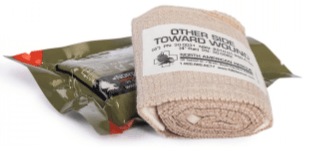
Both of these are made for severe bleeding and are developed to help stop it. Since tourniquets shouldn’t be applied anywhere but your extremities (arms and legs), you’ll need something for your torso, neck, and head in case something happens to those areas of your body.
For heavy bleeding in those areas, these types of gauze is what I’d reach for.
Head Injuries
Head injuries are tough to prepare for if you’re working in an environment where you are the only one around. If they’re bad enough it won’t matter what you have because you might not be capable of doing anything about it.
For this reason, I always have my phone on me and if I’m using hearing protection it’s connected to my phone. If something happens I can use the voice assistant or phone to call for help.
Something a little more likely to happen though is an eye injury. It’s pretty easy to get sawdust or wood chips in your eye if you’re not wearing eye protection and using power tools. It’s happened to me when I’m being careless and it always happens when I’m “doing something real quick.”
Foreign objects in your eyes hurt. Know what doesn’t make it better? Rubbing your eyes is almost always the first reaction your brain makes. It is a great way to scratch up your cornea though.
For this reason, I recommend having a small eye-wash bottle somewhere relatively handy. These purpose-built safety devices could save your vision.
If you’re fortunate enough to have a sink or plumbing in your workshop, you may be able to skip the eye-wash bottle. What you need is a liquid to wash the foreign object out versus using dry hands to try to pick it out.
Miscellaneous First Aid Equipment
Not all shop injuries will be life or limb-threatening. It’s a swell idea to be prepared for smaller injuries in the shop too. Save yourself the trip of walking through your house and maybe leaving blood drops on the floor (or GASP the carpet).
The following first aid supplies are more common and a little easier to get. Making sure you check these items every so often, yearly is probably a good idea, as some of them can become less effective over time.
Bandages
Get a wide assortment of bandages in different sizes. Get some for your knuckles, fingers, and regular bandaids. Grab some waterproof ones and some super sticky ones.
You may want to get some long strip bandages or “skin closures” for long scratches or cuts on your arms that bandaids won’t cover.
Nitrile Gloves
It’s important to be clean any time an injury happens. There’s no point bandaging a wound if the area isn’t clean and you aren’t cleaning a wound if your hands are dirty.
You probably have a box of gloves lying around for the times you apply the finish. Grab some of those and keep them in the first aid kit, out of the dust and safe for when you need them.
Make sure you put in a couple of pairs, just in case. It would really suck to only put a couple of gloves in there and have them rip while you’re putting them on and trying to be safe.
Sharp and Pointy Things
Something that may seem out of place in a shop first aid kit is a scalpel. They seem like they only belong in hospitals or doctor’s offices but they could be helpful in first-aid situations as well. In cases where something is embedded in or under your skin, you don’t want to be using a dirty pocket knife to cut it out, a sterile scalpel makes more sense.
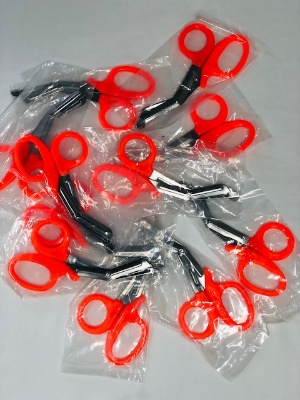
It would be wise to include a pair of scissors or trauma shears. Ok, the name makes them sound serious, but really they’re the crooked scissors you see doctors and EMTs using on your favorite medical show or movie.
If you need to cut off some clothing to address a wound, these will do it.
You’ve probably been waiting for this entire article for me to say tweezers, haven’t you. They really are an amazing little tool for getting out splinters. I like to have a couple of pairs of tweezers laying around the shop so they are rarely out of reach.
The Rest
Even commercial first aid kits don’t always get it right. If you’ve ever looked into the various kits you might actually find yourself asking “what the hell?” First aid suppliers have kits for all sorts of situations: hiking, camping, workshops, general use, trauma, and more.
Something Jonathan pointed out in his video that no first aid kit has is plastic bags. Going back to the beginning of this article, if you accidentally cut off a finger you need somewhere to put it. Ideally, you should place it in a plastic bag, then put that plastic bag in another bag that has ice or cold water in it.
Speaking of ice, get a couple of cold packs or cold compress packs for your first aid kit. The kind where you squeeze to activate is perfect. They’re excellent to apply even if you haven’t broken the skin but there is swelling.
A lot of people swear by using crazy glue to seal small cuts. I haven’t done that myself, but nobody seems to have a strong reason to never do it so I’ll leave that up to you.
That about covers it. Making sure you have a diverse first aid kit or two (two or more if you have a bigger shop or multiple people working in it) is a must, even if you feel like you’re the most careful person on the planet. Someone else may not be and they might get hurt in your shop or, face it, you may not be the most careful person on the planet.
You should also learn how to properly use these items, especially the tourniquet. Take a first aid course if you can. The Red Cross or smaller organizations offer them frequently and a lot of the time they’re free.
Finally, make sure you have a routine for checking your first aid kits regularly. I would suggest they should be checked at a minimum every year. If you want to do so more often, nobody will stop you. If you end up using any supplies from your kit, replace it as soon as possible. Do your best to make sure when something comes out it is replaced quickly.
Opening a first aid kit that doesn’t have the supplies you need is tantamount to not having a first aid kit at all.
